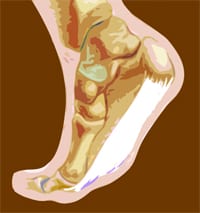Healing the Heel UMass Doctoral Student Takes Steps Against Plantar Fasciitis
AMHERST — A doctoral student in the kinesiology department at UMass Amherst has begun an in-depth study of a foot disorder that affects more than 2 million Americans.
Ryan Chang’s research on the biomechanics of foot muscles and connective tissue will help scientists to understand the mechanisms that cause plantar fasciitis, or chronic heel pain, and may lead to more specialized treatment of the disorder.
Chang said his preliminary results give the first experimental evidence to confirm the theory behind the disorder plantar fasciitis, or chronic heel pain. People with the condition have more flexible arches than those who do not, and the front and back portions of affected feet often move out of sync. Chang’s research will take these results a step further and use magnetic resonance imaging (MRI) and spectroscopy (MRS) to determine the causes of these differences in foot mechanics.
The research is a collaboration between the university’s Biomechanics Laboratory, led by Joseph Hamill, and the Muscle Physiology Laboratory, led by Jane Kent-Braun, in the department of Kinesiology. The MRIs will be performed at Cooley Dickinson Hospital, and the MRS work is a collaboration with Yale University.
“We’re finding that there’s more to foot problems than just the way the foot flexes,” Chang said. “We’re characterizing finer-scale movement patterns and the ways the angles of movement change when you use your foot.”
As a certified pedorthist, Chang designs and manufactures braces that help support the foot and correct its function. He said he hopes his results will improve current treatments for the disorder, which include stretching, muscle strengthening, icing, and wearing specialized footwear and arch supports.
First Steps
The first part of Chang’s study compares the way affected people walk with those who are not affected. In the Biomechanics Laboratory, Chang places 11 pieces of reflective tape on various parts of the foot, ankle, and calf of his subjects. He then films each subject walking along a walkway using several infrared cameras; the video is then used to reconstruct the subject’s movements in three dimensions. The subjects also walk over a force platform that records the levels of force that are exerted by different parts of the foot.
Chang’s initial results suggest that plantar fasciitis patients have more flexible arches that are more easily flattened while walking. Further, the front and rear portions of affected people’s feet do not bend in sync with each other the way a normal person’s foot moves.
The second and third parts of Chang’s project will uncover the mechanisms behind these flexibility and movement issues in plantar fasciitis patients. Using MRI and MRS, Chang’s group will be able to compare the size and shape of the foot’s individual muscles with the amount of energy the muscles produce when a subject walks. Kent-Braun, who specializes in the mechanisms of muscle fatigue, thinks Chang’s results will be especially informative to studies on how people’s muscles change with age.
“Thus far we’ve had no information about the mechanisms of this disorder,” Kent-Braun said. “The structure and the way it functions are so complex, and it’s only recently that we’ve begun to have the tools to examine it.”
Chang was one of only two graduate students invited to present their results at the Prescription Foot Orthotics Labora-tory Association’s annual biomechanics conference in November; the conference traditionally invites Ph.D. scientists and established podiatrists to speak.
Plantar fasciitis, a condition that has been called ‘policeman’s heel,’ is usually felt on the underside of the heel, and is often most intense with the first steps of the day. It is commonly associated with long periods of weight bearing. Chronic heel pain most often affects people whose jobs require them to work on their feet, such as service workers, hospital workers, flight attendants, postal workers, and construction workers, Chang said. Many people affected by the disorder describe the symptoms as a sharp, knife-like pain in their heel.
Obesity, weight gain, jobs that require a lot of walking on hard surfaces, shoes with little or no arch support, and inactivity are also associated with the condition. Many different treatments have been effective, and though it often takes six to 18 months to find a favorable resolution, plantar fasciitis generally has a good long-term prognosis.
The disorder gets its name from the portion of the foot that it is believed to affect: the plantar fascia, which is a strip of connective tissue that attaches to the bottom of the heel and runs along the arch of the foot, fanning out to attach to all five toes. Clinicians have traditionally associated the painful symptoms with over-stretching and inflammation of the connective tissue, but this correlation has never been proven.
“One of the biggest problems is that there’s no good way to diagnose this disorder based on people in a static position,” Hamill said. “If you’re standing, you’re not going to see a problem that’s a result of motion. You have to watch a person walking to understand why they have that pain.”
Standing Offer
The scientists are seeking otherwise healthy, non-obese people between the ages of 30 and 55 for participation in this study.
Anyone who fits these criteria and has been diagnosed with plantar fasciitis or has experienced its symptoms can call (413) 545-4421 or E-mail Chang atryanc@kin.umass.edu for further information. Qualified subjects will receive a free custom set of foot orthotics.


